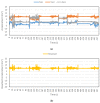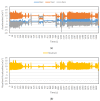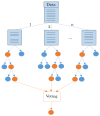Travel Mode Detection with Varying Smartphone Data Collection Frequencies
- PMID: 27213380
- PMCID: PMC4883407
- DOI: 10.3390/s16050716
Travel Mode Detection with Varying Smartphone Data Collection Frequencies
Abstract
Smartphones are becoming increasingly popular day-by-day. Modern smartphones are more than just calling devices. They incorporate a number of high-end sensors that provide many new dimensions to smartphone experience. The use of smartphones, however, can be extended from the usual telecommunication field to applications in other specialized fields including transportation. Sensors embedded in the smartphones like GPS, accelerometer and gyroscope can collect data passively, which in turn can be processed to infer the travel mode of the smartphone user. This will solve most of the shortcomings associated with conventional travel survey methods including biased response, no response, erroneous time recording, etc. The current study uses the sensors' data collected by smartphones to extract nine features for classification. Variables including data frequency, moving window size and proportion of data to be used for training, are dealt with to achieve better results. Random forest is used to classify the smartphone data among six modes. An overall accuracy of 99.96% is achieved, with no mode less than 99.8% for data collected at 10 Hz frequency. The accuracy is observed to decrease with decrease in data frequency, but at the same time the computation time also decreases.
Keywords: classification; moving window; random forest; smartphone; travel mode.
Figures
















References
-
- Stopher P.R. Transport Survey Methods, Keeping up with a Changing World. Emerald Group Publishing; Bingley, UK: 2009. The travel survey toolkit: Where to from here; pp. 15–46.
-
- Wolf J., Guensler R., Bachman W. Elimination of the travel diary: Experiment to derive trip purpose from global positioning system travel data. Transp. Res. Rec. J. Transp. Res. Board. 2001;1768:125–134. doi: 10.3141/1768-15. - DOI
-
- Hato E. Development of MoALs (Mobile Activity Loggers supported by GPS-phones) for travel behavior analysis; Proceedings of the Transportation Research Board 85th Annual Meeting; Washington, DC, USA. 22–26 January 2006.
-
- McGowen P., McNally M. Evaluating the potential to predict activity types from GPS and GIS data; Proceedings of the Transportation Research Board 86th Meeting; Washington, DC, USA. 21–25 January 2007.
-
- Hato E. Development of behavioral context addressable loggers in the shell for travel-activity analysis. Transp. Res. Part C Emerg. Technol. 2010;18:55–67. doi: 10.1016/j.trc.2009.04.013. - DOI
LinkOut - more resources
Full Text Sources
Other Literature Sources

